Top News
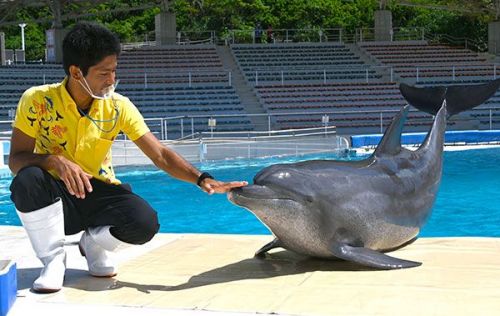
October 5, 2020 Ryukyu Shimpo
Okichan Theater is located at Ocean Expo Park in Motobu, Okinawa, and is named after Okichan, the female Indo-Pacific bottlenose dolphin. She has been with the park for 46 years and currently holds the longest dolphin rearing record in Japan for the same species. The Ocean Expo Park reopened its doors on October 1 after temporarily closing due to the novel coronavirus pandemic. Okichan Theater has also resumed its shows, and Okichan entertained visitors with her powerful jumps.
Indo-Pacific bottlenose dolphins are found around the world in warm and tropical climates. Domestically, they live in the waters near the Ogasawara Islands and the Amami area. They inhabit coastal areas unlike other dolphin species, making bycatch and vulnerability to environmental pollutions a concern.
Okichan is about 2.4 meters long and weighs 173 kilograms. She was brought to Ocean Expo Park from Amami Oshima by air in 1975 as the mascot for the International Ocean Exposition Okinawa, where she performed a show. The Okichan Theater has been a permanent fixture since, and Okichan continues to show off her enthusiastic swimming. She can expertly jump up to 4 meters, toss balls and hoops, and currently leads the pack, which comprises eight dolphins of six species including Okichan. Suguru Higa, 31, is the dolphin and manatee handler of the park’s marine animal division within the aquarium operation department. Higa said, “We are always looking after the dolphins’ wellbeing, but Okichan never gets sick. That’s her secret to longevity.”
As the novel coronavirus spread, the theater had to close at the end of February for an extended time. Higa recalled, “There’s no way to communicate to the dolphins that there will be no shows. So we practiced during the shutdown and made sure the dolphins maintained the same routine as before. The handlers also had to take care of themselves too, but we made sure to catch the slightest change in our dolphins.”
Spectators returned to Okichan Theater for the first time in seven months on October 1 when the show resumed. Okichan put on an energizing show with the other dolphins, while the mask-wearing crowd took photos and cheered on.
After the show, Higa rubbed Okichan’s snout and said, “I hope to continue sharing the allure of sea creatures with our visitors.”
(English translation by T&CT and Monica Shingaki)
Go to Japanese
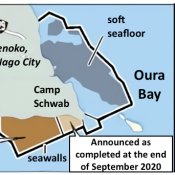
October 1, 2020 Ryukyu Shimpo online edition
The Okinawa Defense Bureau (ODB) has recently announced that one part of the land reclamation work for Futenma Replacement Facility construction in Henoko, Nago City, was finished. In response to this, on October 1 Okinawa Governor Denny Tamaki stated in writing that the construction completed is “merely a portion of all the construction” needed for this one part of land reclamation.
Governor Tamaki said that the ODB’s political approach is to make it seem as though construction is progressing favorably by completing land reclamation in one part of the zones. According to preliminary calculations by the Okinawa Prefectural Government (OPG), by the end of August the amount of soil deposited would reach 3.2 percent of the total amount, and as such Governor Tamaki emphasized that, in the current circumstances, it is difficult to imagine land reclamation being completed as a whole.
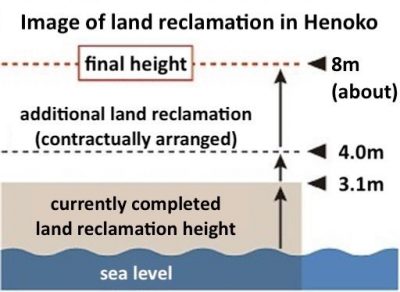
Soil deposits into the land reclamation zone close to Cape Henoko were started in December 2018. On October 1, the OBD announced that land reclamation to the height reported to the OPG was completed on September 30, 2020. The height reported to the OPG is, for the most part, to a height of 3.1 meters above sea level, and 4 meters above at portions of the seawalls. Further land reclamation is necessary to reach completion in this part of the land reclamation zones.
In March this year, the ODB ordered additional soil for construction. Furthermore, it can be seen in ODB documents that the final height of the outer peripheral sea walls is to be 8.1 meters above sea level, and the final height of the land-reclaimed earth is also to be raised to about 8 meters above sea level.
Construction to the height of 3.1 meters above sea level in the part in question, which was recently announced as completed by the ODB, was initially scheduled for completion by March 2020. However, after two extensions, the schedule for completion was changed to the end of September.
Meanwhile, soft seafloors have been found in the ocean area scheduled for construction on the Oura Bay side of Cape Henoko, and the ODB cannot start construction there. An application is being filed with the OPG so as to change the plan to include ground improvement work and to reapprove the plan.
(English translation by T&CT and Erin Jones)
Go to Japanese
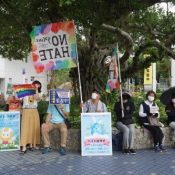
October 1, 2020 Ryukyu Shimpo
The “Silent Standing,” a silent protest that takes place in front of Naha City Hall every Wednesday, which protests against street-level propaganda that discriminates against Chinese residents and fans the flames of hate, entered its 20th week on September 30. According to the citizens protesting, the street level propaganda has not been seen in the 20 weeks they have been protesting, starting May 20.
On this day, 30 people from around the prefecture gathered to participate in the protest, holding up signs with messages such as “Hate is bad” and “No Place for Hate.”
The local group “Okinawa Counters” submitted a petition to the Okinawa Prefectural Assembly at their regular session in June, demanding they enact laws that prohibit hate speech. The assembly plans to deliberate on the issue during their in-progress regular September session.
One man, 48, an office worker who has continued to participate each week, said, “I wholeheartedly want to stop hate speech.” A 50-year-old woman from Naha who has been participating said, “If the laws to prohibit hate speech are enacted, it gives us a chance to teach people that these kind of hateful activities happen even in Okinawa.”
(English translation by T&CT and Sam Grieb)
Go to Japanese
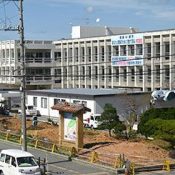
October 1, 2020 Ryukyu Shimpo
Ginowan – On September 29, Masanori Matsugawa, mayor of Ginowan City, spoke at City Hall about how it has been eight years since the deployment of MV-22 Osprey vertical takeoff and landing aircraft to Futenma Air Station. He called for “halving the number of osprey aircraft (there are currently 24) and for as many training exercises as possible to occur outside of Okinawa Prefecture.” He also demanded thorough safety management because the air base is surrounded by dense city areas.
When the osprey aircraft were deployed, Matsugawa was deputy mayor. On the day that the aircraft arrived on Futenma Air Station, Matsugawa watched them land from the roof of City Hall in Nodake. With him were Hirokazu Nakaima and Atsushi Sakima, who at the time were Governor of Okinawa and Mayor of Ginowan City respectively. Osprey aircraft produce low frequency sounds and a rumbling bass which can be felt in homes in Nodake when one of the planes flies overhead.
In his comments, Matsugawa reflected on the many accidents that occurred as the planes were coming into use. The U.S. Military has asked Okinawans to be understanding of the flight training, but Matsugawa says, “We can’t just agree to this.’” He continues, “We have to demand that they make sure there are no aviation accidents.”
(English translation by T&CT and Ellen Huntley)
Go to Japanese
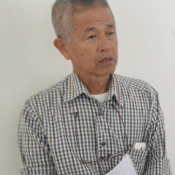
September 29, 2020 Ryukyu Shimpo
On September 28, Takamatsu Gushiken, representative of “Gamafuya”, a volunteer group for collecting human remains from the Battle of Okinawa, submitted a letter requesting that the Okinawa Prefectural Government not approve the plan to use the southern part of Okinawa Island as a site for extracting earth and sand to be used for land reclamation in the new base construction in Henoko, Nago accompanying the relocation of U.S. Marine Corps Air Station Futenma. Explaining that the remains of people who died in the Battle of Okinawa are still buried in the limestone in the southern part of Okinawa Island, Gushiken criticized the plan, saying that building a new base using soil from there would constitute “desecration of the war dead.”
Extraction of earth and sand from the southern part of Okinawa Island was newly included in the construction design change application submitted to the Okinawa Prefectural Government by the Okinawa Defense Bureau in April 2020. Gushiken submitted his letter in response to the Prefectural Government’s solicitation of public comments in its process of reviewing the design change permit application.
“The remains have changed to the same color as the limestone and the earth. It is nearly impossible to distinguish them by sight, and they can only be distinguished by their weight when held in one’s hand,” explained Gushiken, who has worked on gathering human remains for more than 30 years. He is concerned that when the earth is excavated by machinery, it will have human remains mixed therein. He emphasized that human remains have in fact been discovered in quarries in the southern part of Okinawa Island in Kyan, Itoman and Nakaza, Yaese.
Gushiken intends to make a similar petition to Governor Denny Tamaki going forward. After submitting his letter, he told reporters, “For a country that carried out war to use earth in which human remains are intermixed to build a military base is an act that shows not a trace of respect for the dignity of those whose lives were sacrificed. I will continue my appeal together with the families of the deceased.”
(English translation by T&CT and Sandi Aritza)
Go to Japanese
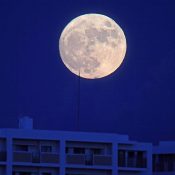
October 2, 2020 Ryukyu Shimpo
Jugoya, or Harvest moon, is celebrated on August 15 on the lunar calendar which fell on October 1 this year. High atmospheric pressures brought clear skies over Okinawa, providing a spectacular view of the chushu-no-meigetsu (mid-autumn moon).
Some neighborhoods in Okinawa celebrated jugoya by preparing fuchagi (mochi rice cakes sprinkled with red bean) as food offerings to the deities, and enjoyed the moon viewing. Standing on the Tomari Ohashi bridge in Naha City, a big round moon emerged in the east shortly after 6 p.m. from behind residential and commercial buildings. The mid-autumn moon gradually climbed up the night sky and illuminated the city.
(English translation by T&CT and Monica Shingaki)
Go to Japanese
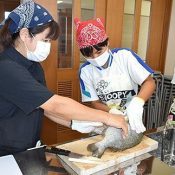
September 29, 2020 Ryukyu Shimpo
By Yukito Kinjo
Ie – In preparation for the “Age 15 island departure,” when students leave Ie island to go to high school, the Ie Fishing Cooperative (Ryuichi Hachimae, president) held a “Fish Cooking Classroom” for 49 3rd-year students at Ie Junior High School (Manabu Tamaki, principal), where they learned things such as how to prepare a fish for cooking.
When students go to Okinawa’s main island for high school, they also need to start cooking for themselves. The lessons are held every year, and stress the importance of cooking for yourself as well as fosters a sense of independence that is linked to leaving one’s home island to pursue education. They learned to cook using mibai (Malabar grouper) and taman (spangled emperor) fish.
The cooking lesson was carried out following the guidelines set in place to help prevent the spread of COVID-19, and for the first time fishing cooperative president Hachimae joined the class as a fish preparation instructor. The students experienced for the first time grappling with the proper way to remove the fishes’ scales an innards, then cut the mibai into cubes for a fish soup, and cut the taman into filets and prepared them in a meunière sauce.
Before cooking, fishing cooperative member Kazuyoshi Miyazato gave a demonstration on portioning a 35 kg yellowfin tuna, captivating students and teachers alike with his magnificent knife-work. The portioned tuna was then cut into sashimi by the students. The three dishes were then lined up on the table, and the students and fishing cooperative members enjoyed a luxurious lunch together. One student, Masato Akata said, “preparing the fish was tough, but managing the fire level and the seasoning was also difficult. I want to practice at home before leaving the island.”
Third-year teacher Akihiro Hiyane said, “The class works with local people, helps build pride for our island, and we hope it produces wonderful adults that come back to the island, and I thought the class went very well.”
(English translation by T&CT and Sam Grieb)
Go to Japanese
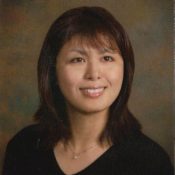
September 29, 2020 Ryukyu Shimpo
The Nakamura Iwao Challenge Foundation awards its Rocky Challenge Prize to Okinawans with global ambitions who serve as a role model to Okinawan youth. This year’s Rocky Challenge Prize will be awarded to Dr. Sakura Kinjo, an anesthesiologist and clinical professor at the University of California San Francisco. Dr. Kinjo, an Okinawa City native, will be the eleventh recipient of the Rocky Prize. The award ceremony will take place virtually on November 7, during the Fifth Ryudai Mirai Kyoso (Co-create the Future) Forum.
Dr. Kinjo earned her medical degree at the University of the Ryukyus (Ryudai) School of Medicine and completed her internship at a U.S. military Navy Hospital in Okinawa. She then served as an assistant lecturer for the Department of Anesthesiology at the Ryudai School of Medicine, lecturer for the Department of Anesthesia and Perioperative Care at UCSF from 2005, and assumed her role as the anesthesia medical director at UCSF Orthopaedic Institute when it opened in 2009. Dr. Kinjo was chosen for the Rocky Prize for her cutting-edge medical work in the U.S. and her active role in bridging scholarly exchanges between Japan and the U.S.
The Rocky Prize was founded in 2010 by Iwao Nakamura, former president of Nissan Diesel Kogyo, using his personal funds. Nakamura is a Naha City native currently residing in Kanagawa Prefecture. At the award ceremony, Dr. Kinjo will be awarded one million yen and a plaque.
(English translation by T&CT and Monica Shingaki)
Go to Japanese
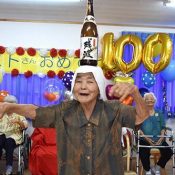
September 20, 2020 Ryukyu Shimpo
By Chie Tome
(Yomitan) On September 16, a birthday party for Umeto Yamashiro, age 99, of Owan, Yomitan, who is active as the “poster girl” for the Okinawa tourism theme park “Ryukyu Mura” in Onna, was held at the day service center “Ikiru Ie” in Toya, Yomitan to celebrate her 100th birthday according to the traditional Japanese age-counting system. Yamashiro played the tones of the sanshin herself during the opening Kagiyadefu performance, and during the climax Kachashi dance she danced gracefully with a 1.8 liter sake bottle (Issyo bin) balanced on her head. “I’m only 100. I always feel like I’m 20. I’m right in the midst of my youth!” Yamashiro said with a carefree smile, bringing smiles and laughter to everyone’s face.
Yamashiro was born on September 20, 1921, and was raised in Zakimi, Yomitan. She says that she was very introverted in her youth and had a shy personality. She experienced the Battle of Okinawa when she was 24 years old. She was pregnant during the war, and took refuge in Yambaru in the north with her younger siblings. Her eldest daughter was born in June, at the height of the battle. After the war, she worked at a retail store in Owan, Yomitan, and had two daughters and five sons.
Yamashiro has a vivacious willingness to challenge herself no matter her age. She started learning to play the sanshin at age 60, and got certified to teach classical Ryukyu music at age 80. She loves to study, and to this day is working on her Shimakutuba, dance, and calligraphy skills.
Yamashiro came to be “employed” at Ryukyu Mura in her 80s, when someone working there heard that there was a lively old woman in Yomitan who could sing, dance, play the sanshin, and speak Shimakutuba. She became famous overnight when she appeared in a TV commercial as the poster girl for the theme park, and she says she has been interviewed nine times by international media from places like Russia and the United States.
The smile never fades from Yamashiro’s face. She said that smiling is the source of good health, and expressed renewed enthusiasm for the future, saying, “I want to continue enjoying every day with a smile on my face.”
According to Takako Shimabukuro, representative of the center, Yamashiro gives various advice to the employees there as someone with a wealth of life experience. In particular, she always says, “don’t scold your children; praise them instead.” “I think it would be wonderful if I can grow old like Umeto. She is also a star of hope for the others here,” said Shimabukuro with a smile.
“She is so lively, I can hardly believe she is ten years my senior,” said Haru Yamauchi, age 90, of Nagahama, Yomitan, who also attends the center. “I want to follow Umeto’s example and live to an old age in good health.”
(English translation by T&CT and Sandi Aritza)
Go to Japanese
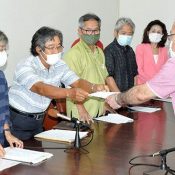
September 24, 2020 Ryukyu Shimpo
The “We don’t need a missile base Miyakojima resident liaison council,” (Seihan Nakazato, representative) which is made up of citizens groups from the Miyako region, submitted a request to Okinawa Prefecture asking the government to not allow the Japanese Self-Defense Forces (JSDF) to use Shimojishima airport, in accordance with the “Yara Memorandum,” which designates it solely for private use. Okinawa Prefectural Government’s Civil engineering and construction section head Kunisada Uehara said, “We will continue to use [the airport] while respecting the Yara Memorandum, and our previous policy will not change,” reaffirming their policy of not allowing the airport for use by the military.
The Liberal Democratic Party’s (LDP) National Congressional Defense Alliance asked then-Minister of Defense Taro Kono to allow the JSDF to use Shimojishima Airport in August, to which the liaison group indicates, “Allowing the JSDF to use Shimojishima airport necessarily also includes an influx of the U.S. military onto Miyako Island.”
With Shimojishima’s new project of equipping the airport with the capability of operating as a spaceport, there was worry that the sub-orbital flight technology could be diverted for military use. Uehara said, “Through and through it will be for private space flight,” indicating that it would not be diverted for military use.
Group representative Nakazato praised the prefectures response, saying, “We received a reassuring answer.” The appeal was also attended by Councillors Yoichi Iha and Tetsumi Takara, Representative Tomohiro Yara, and members of the prefectural assembly. A similar petition has been submitted to the Okinawa Prefectural Assembly.
(English translation by T&CT and Sam Grieb)
Go to Japanese
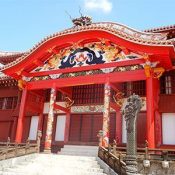
September 24, 2020 Ryukyu Shimpo
On September 23, Okinawa Prefecture and the Cabinet Office’s Okinawa General Bureau signed a memorandum to procure large-diameter logs for the reconstruction of Shurijo Castle, which was destroyed in a fire last October. The Okinawa General Bureau will determine the specifications for the large-diameter logs which will be used for the structural frame of the castle and notify the prefecture. The prefecture will then procure the lumber using the donations it received domestically and from abroad. Purchase orders are expected to be issued next April. At present, the wood type, quantity, and origin are yet to be decided. It is the first time the prefecture is working in conjunction with the Okinawa General Bureau to set rules on how to utilize donated funds.
In addition, the prefecture and the Okinawa General Bureau are in talks to utilize the donated funds for purchasing red roof tiles, reconstructing the great dragon pillars, the Karahafu Tsuma-kazari (gable embellishments), Ryuto Muna-kazari (dragon-head roof ornaments), and the hengaku (name plaque).
(English translation by T&CT and Monica Shingaki)
Go to Japanese












 Webcam(Kokusai Street)
Webcam(Kokusai Street)


